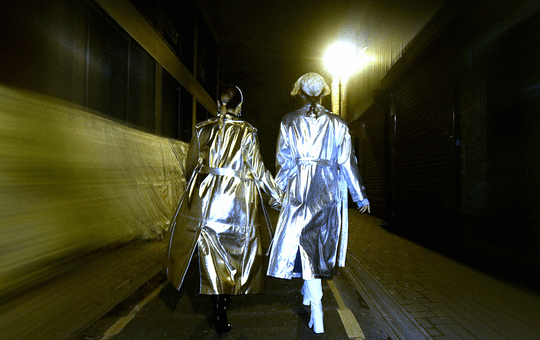The story behind Lukid's mesmerising debut film score
“Dreams pivot on hundredths of seconds,” says a coach at a key moment in Personal Best, a stunning new documentary film about the agonies and ecstasies of the athletics world. Four years in the making, it’s not a film about running so much as a human study in focus and sacrifice. With grace and tenderness, it gets inside the headspace of four young Olympic hopefuls who spend their whole lives training for those crucial few seconds on the track.
It is the work of film maker and Werk Discs associate Sam Blair, his first feature film and made with the silver screen in mind. “Cinema has this huge range and you can use that to really shout loudly, but you can also whisper,” says Sam. “You can focus in on the tiniest thing, you can slow it down to a standstill.”
The time-stopping magic of Personal Best owes much to the score by Sam’s brother Luke Blair – better known as producer Lukid – and sound designer Gunnar Oskarsson. Ahead of its premiere this weekend in London (full dates below), the three collaborators share their illuminating stories of the making of the soundtrack below.
How instrumental was the music to the making of Personal Best?
The music is really important in mapping out the emotional arch of the film.” Sam Blair
Sam Blair: It turned into a film with a lot of music in it. I don’t know that was the intention at the start – but as it went on it just worked out that way. Music is a hugely evocative part of any film – which is why some films at the more austere end of the scale avoid it altogether. I worry that there is too much music in there, but with this film there was always going to be a heightened, stylised aspect to it, with the use of slow-motion, for example. So the music is used to draw us into those spaces, that heightened world. But the music is also really important in mapping out the emotional arch of the film. I decided, at some point, not to restrain the emotion, but to try to really emphasise it – to create powerful moments and emotional high-points in the film. This was quite a big decision for me as my nature is to be subdued and I like to underplay things, but I decided I didn’t want to bore the tits off an audience so we just went for it.

Richard Alleyne, sprint hurdler, during weight training
What were your starting points or touchstones for the score?
“The Popul Vuh soundtrack to the Herzog documentary The Great Ecstasy Of The Sculptor Steiner has been something that me and Sam have talked about for years.” Lukid
Luke Blair: The recent Trent Reznor scores for The Social Network and The Girl With The Dragon Tattoo were something that we discussed a lot, I think particularly for how much they got out of very simple but strong ideas. The Popul Vuh soundtrack to the Herzog documentary The Great Ecstasy Of The Sculptor Steiner has been something that me and Sam have loved and talked about for years, and was a definite influence for me at least with this project, as it’s a sport documentary in which the music managed to add stillness and poignance to a very fast and frenetic sport (ski jumping), which is something I think Sam wanted to achieve at times with Personal Best.
Gunnar Oskarsson: [The] starting point was the conversation we had about the different elements of the film, one of them being this “zone” that the athletes talk about getting into, where everything seems to come together without you having to force anything. They often can’t remember exactly what they were doing when they ran their winning races, it all just came naturally. Like with anything in life, the biggest challenge succeeding in sport is the mental aspect, you have to get over these mental hurdles in your mind, be disciplined and positive etc. So much of the performance is mental and the music in the film is all about that mental world. Whether it’s the struggle, positivity, hope or defeat, it was all about bringing the audience into that mental state.

2008 Olympic Finalist Jeanette Kwakye preparing during training
To me, it feels like the music is very much the glue that holds the film together. Is it all original material and could you tell me a little about its composition?
Luke Blair: It’s all original material, yes. Some of it was done by me alone in my studio, that was during the time when Sam was still editing the bulk of the film and he’d be sending me images and sequences and I’d be sending him ideas and loops back, seeing what he liked and giving me pointers. When the editing and sound editing were pretty much done the three of us got together in Gunnar’s studio for about three weeks and scored the rest of the film.
Sam Blair: Gunnar had written some beautiful guitar parts that he then collaborated with Luke on to complete. We were literally finishing the music the night before the sound mix.
“So much of the performance is mental and the music in the film is all about that mental world.” Gunnar Oskarsson
Gunnar Oskarsson: Some of it was composed in Iceland but most of it in London. Iceland is a good place for me to tap into this inner world we all have and one particular track was composed there, which has a sense of dreams and hope to it. The other big element of the score is the London element. The athletes are all training in London and London has a particular feeling to it. When you’re here you’re very much affected by the city, as it’s very hard living here for various reasons but can also be very rewarding. It’s got an energy all of it’s own, and a lot of the music has that in it and that was a conscious decision, to bring that element out in it, more in some points of the film than others.

“Dreams pivot on hundredths of seconds.” John Powell, coach
How did the three of you work together?
“Sound has no limits – it doesn’t have to be tied to reality in the same way the shooting and editing of the documentary is.” Sam Blair
Sam Blair: Me and Gunnar have a great working relationship that we have built up from film school, working on quite a few films together now. Working with him is my favourite part of the process, because sound has no limits – it doesn’t have to be tied to reality in the same way the shooting and editing of the documentary is. We talk a lot about the point at which sound design and music cross over. I guess most people don’t realise that every scene in a film has had “room tones” and atmospheres applied to it. Layers and layers of sound that help to situate the audience in the film, but then can also be used to create feeling, tension etc. You can push those sounds into interesting places and they can become very musical. It depends how far you want to go down that road. So me and Gunnar worked on the sound design for a while talking about such things and then Luke came in and became part of that conversation.
Luke Blair: It was quite a simple set up we had at Gunnar’s; guitar, piano and synth. So we would get the scene we were composing to up on the screen, and sit around and try to come up with something. Sometimes it would be me and Gunnar at the piano/guitar and Sam would be lying on the sofa, occasionally shouting “that’s a bit Karate Kid 2”, or “too Grange Hill”, and conduct the whole thing that way. It was actually a very effective way to work, and as someone who is used to working alone it was great to have two other people to bounce ideas off.
Sam Blair: Very late on we made a track which is this very moody, spacious guitar and piano piece that as soon as we heard we just grabbed hold of and sort of plastered it all over the film, because it was so right – but I guess that could have only happened after all the discussion and experimenting that had gone before.

World Championships sprinter James Ellington reflecting after the race
The music seems to feed into the cinematography as much as the cinematography feeds into the music. Was that relationship as symbiotic as it feels?
Sam Blair: Jean-Louis Schuller, the cinematographer, is a very talented cameraman who can shoot documentary incredibly beautifully. It is a real skill to be able to capture reality in that way. I am a big fan of portraiture in cinema – I like seeing faces and the film has lots of lingering close-ups. What that then allows is room for the sound and music to bring us into the characters head-space. I think the film flows pretty nicely and again that is down to Jean-Louis’ ability to shoot a scene fluidly – to react to what’s happening in the moment and flow with it – moving the camera at the perfect moment and not jumping all over the place. This softens the films edges and keeps the audience in the moment, rather than cutting like mad. I guess the meditative, flowing aspect to the music then combines with that.
Gunnar Oskarsson: For me the cinematography was hugely influential on both the sound and the music. Jean Louis, Sam and I have been working together since film school and I think we gravitated towards each other there because we have a similar aesthetic and like to tell a story in a certain way. And by now, I know what Sam likes and how Jean Lois goes about capturing that, I know how they work together and for me it’s a very natural slide into that world. Sam’s filmmaking has a certain view, a certain rhythm, it’s very internal at times and personal and I think we tune into that together and try and bring it out as best we can.

18-year-old Omardo Anson in action
It’s been a long time in the making. What’s it like seeing the final film?
Luke Blair: Amazing and emotional, especially watching it with the athletes. This is the first thing like this I’ve done, and when you’ve worked on something so closely it’s a completely different viewing experience, as you’re noticing every tiny detail, every little sound effect and every bit of reverb. Also, from a selfish point of view, and as a massive film fan, it was a very nice feeling to hear music I had made in a cinema.
Catch Personal Best at the following cinemas:
Curzon Soho, London 26-27th May, 12noon/2.10pm
Ritzy Brixton, London 28th May, 6.30pm (Q&A)
Hackney Picturehouse London – 29th May, 6.45pm (Q&A)
Lexi Kensal Rise, London 6th June (Q&A)
Greenwich Picturehouse, London 7th June, 8.30pm (Q&A)
Stratford East Picturehouse, London 11th June, 6.40pm (Q&A)
Eastend Film Festival, London 7th July
Stratford East Picturehouse, London 9-12th July
MAC Birmingham 11-12th July
Riverside, Hammersmith 11th July (Q&A)
Filmhouse, Edinburgh 20-23th July
Chapter, Cardiff 20-26th July













